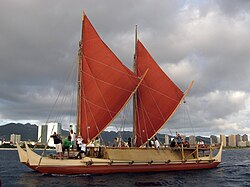Cascos are flat-bottomed square-ended barges from the Philippines. They were used mostly to carry cargo along lakes and rivers, and as lighters to transport goods and passengers to and from moored ships. [1] Though they resemble the sampan, they are much larger with two detachable masts with junk rigs made of woven fiber. They also possess outrigger-like platforms along the entire length of the sides, which is used by punters with barge poles when traversing shallow water. They were steered by an oar or a central rudder by a helmsman housed in a small raised platform at the stern. The entire deck is covered almost entirely in removable curving or pitched panels. [2] [3]
Cascos were most prevalent in southern Luzon, particularly along the Pasig River and Laguna de Bay, as well as in the Manila Bay harbor. [2] [3] In the late 18th and early 19th centuries, they were often strung together in a train drawn by a steamship (vapor). They were used as transport ships by American troops in Laguna de Bay during the Philippine–American War. [4] Cascos are still used today in fluvial parades. An example is during the celebrations of Our Lady of Peñafrancia in Naga City, Bicol. [5] [6]
- Casco (foreground) in Manila (c. 1900)
- Drawing of a casco (c. 1906)
- A casco in Manila Bay in full sail (c. 1906)
- An 1855 woodcut with a casco (left) in a woodcut on the entrance to the Pasig River from Manila Bay
- A casco with two punters (1873)
- Vista del Puente de Manila, an 1847 painting by José Honorato Lozano showing a casco (center left) and several sampans and other river boats










